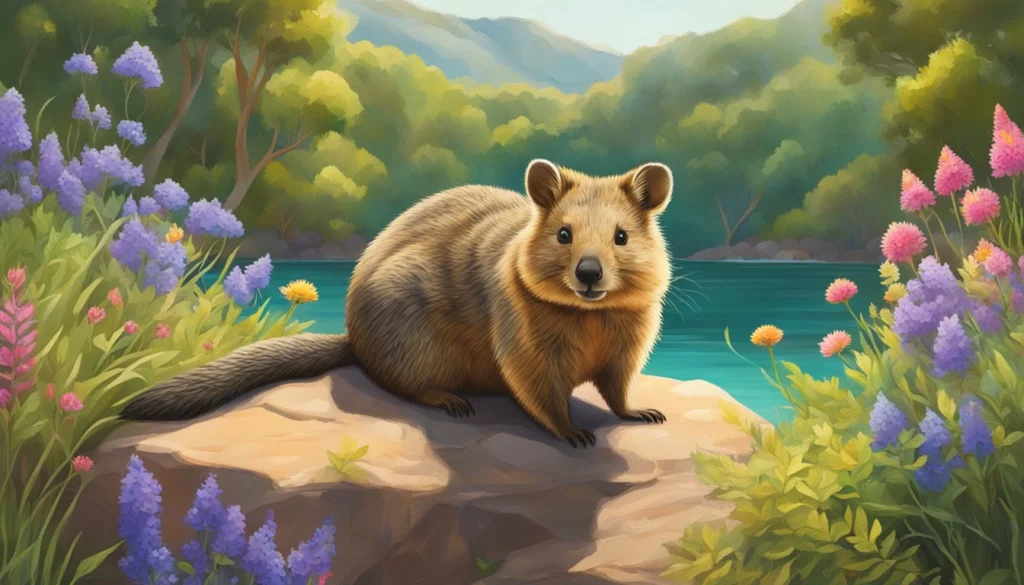The Quokka (Setonix brachyurus) has gained worldwide fame for its adorable appearance and cheerful expression, leading many to dub it the “happiest animal on Earth.” Native to Western Australia, this small marsupial has become a social media sensation, with people traveling from around the globe to snap selfies with these friendly creatures.
But beyond their cute looks and photogenic smiles, Quokkas have fascinating behaviors and adaptations that help them thrive in their unique habitat. In this article, we’ll explore some amazing facts about the Quokka, its habitat, diet, and why it’s considered one of the friendliest animals on the planet.
What Is a Quokka?
The Quokka is a small marsupial closely related to kangaroos and wallabies. It is the only member of the genus Setonix, and while it shares some characteristics with its larger relatives, it has its own unique traits. Quokkas are known for their round, compact bodies, short tails, and large, expressive eyes, all of which contribute to their undeniable cuteness.
1. Size and Appearance
Quokkas are relatively small, typically weighing between 5 to 11 pounds (2.5 to 5 kg) and standing about 16 to 21 inches (40 to 54 cm) tall. Their fur is soft and brownish-gray, often with a slightly reddish tinge around the face. Unlike kangaroos, which have long, powerful tails for balance and movement, the Quokka has a short, stubby tail that is not used for hopping.
The most defining feature of the Quokka is its constant “smile”—a result of the shape of its mouth and facial structure. This characteristic, combined with its round face and bright eyes, gives the Quokka its reputation as the happiest animal on Earth.
2. Marsupial Features
Like kangaroos, Quokkas are marsupials, meaning they give birth to underdeveloped young that continue to grow in a pouch on the mother’s belly. The baby, known as a joey, remains in the pouch for several months before venturing out into the world.
Where Do Quokkas Live?
Quokkas are primarily found in Western Australia, where they inhabit a range of environments. However, they are most famously associated with Rottnest Island, a small island off the coast of Perth that is home to a large population of Quokkas.
1. Rottnest Island
Rottnest Island is perhaps the best-known habitat of the Quokka, and it has become a major tourist destination for those hoping to spot these adorable creatures. In fact, the island was named after the Quokka—Dutch explorer Willem de Vlamingh mistook the animals for large rats, naming the island “Rattennest” (meaning “rat’s nest”), which later evolved into “Rottnest.”
Rottnest Island provides the perfect habitat for Quokkas, with its scrubland, low forests, and grassy areas. The island is free of large predators, which has allowed the Quokka population to flourish.
2. Mainland Habitats
While Rottnest Island is the most famous home of the Quokka, there are also populations on the Australian mainland, particularly in areas of dense forest and shrublands in the southwest of Western Australia. However, these mainland populations are more vulnerable to predators such as foxes, wild cats, and dingoes.
What Do Quokkas Eat?
Quokkas are herbivores, and their diet consists mainly of grasses, leaves, shrubs, and succulent plants. They are well-adapted to their dry environments and can survive on a relatively low-water diet, obtaining much of the moisture they need from the plants they consume.
1. Diet on Rottnest Island
On Rottnest Island, Quokkas feed primarily on native grasses, leaves, and plants that grow in the scrubland. They have a particular fondness for the leaves of peppermint trees, which are abundant on the island. During dry periods, they may also eat bark, stems, and roots to supplement their diet.
2. Adaptation to Dry Conditions
Quokkas are highly adapted to living in environments where water is scarce. They can go for extended periods without drinking, as their diet provides most of the moisture they need. In times of drought, they are known to conserve energy by reducing their activity levels, allowing them to survive on minimal resources.
Quokka Behavior: Why Are They So Friendly?
Quokkas are known for their curious and friendly nature, particularly around humans. On Rottnest Island, where they have become accustomed to tourists, they often approach people and seem unbothered by their presence. This has led to the viral trend of tourists taking “Quokka selfies,” which have further boosted the animal’s popularity.
1. Lack of Natural Predators
One reason for the Quokka’s friendly behavior is the absence of natural predators on Rottnest Island. Without large carnivores to fear, Quokkas have evolved to be more trusting and less skittish around other animals, including humans. This lack of fear has made them particularly approachable, though it’s important for visitors to remember not to touch or feed them, as human food can be harmful to their health.
2. Nocturnal Lifestyle
While Quokkas are often seen during the day, they are primarily nocturnal animals. They spend the daytime resting in shady areas or hiding in thick vegetation to avoid the heat, becoming more active in the late afternoon and evening when temperatures are cooler. This behavior helps them conserve energy and avoid overheating in the hot Australian sun.
3. Social Structure
Quokkas are social animals and tend to live in groups, particularly on Rottnest Island, where resources are plentiful. Within these groups, they display cooperative behaviors, such as sharing shelter and foraging together. However, they do not form the complex social hierarchies seen in some other mammals.
Reproduction and Life Cycle
Quokkas have a unique reproductive cycle that allows them to adapt to changing environmental conditions. As marsupials, their young are born in an underdeveloped state and continue to grow inside the mother’s pouch.
1. Joey in the Pouch
After a one-month gestation period, the Quokka gives birth to a tiny, jellybean-sized joey. The joey immediately crawls into the mother’s pouch, where it continues to develop for the next six months. During this time, the mother provides it with nutrients and protection.
2. Leaving the Pouch
After six months, the joey is large enough to leave the pouch and begin exploring its surroundings. Even after leaving the pouch, the joey will continue to nurse from the mother for another couple of months until it is fully weaned.
3. Breeding Cycle
Quokkas are capable of delayed implantation, meaning that if the joey does not survive, the mother can immediately give birth to another, ensuring the species’ survival even in tough conditions. Quokkas usually breed once a year, but under favorable conditions, they may reproduce more frequently.
Quokka Conservation: Are Quokkas Endangered?
Despite their thriving population on Rottnest Island, Quokkas face significant threats on the mainland. Habitat loss, climate change, and introduced predators have led to a decline in Quokka numbers in many areas.
1. Threats on the Mainland
On the Australian mainland, Quokka populations have been severely impacted by the introduction of predators such as foxes, feral cats, and wild dogs. These predators, combined with habitat destruction due to agriculture and urban development, have reduced the Quokka’s range and put pressure on their populations.
2. Protected Status
Quokkas are currently classified as vulnerable on the IUCN Red List. Conservation efforts have focused on protecting their habitats, particularly on Rottnest Island, where their population remains stable. Predator control programs and habitat restoration projects are also helping to protect mainland Quokka populations.
3. Tourism and Conservation
While tourism on Rottnest Island has helped raise awareness about Quokkas, it also poses challenges. Increased human interaction can lead to Quokkas being exposed to unhealthy foods, which can cause illness. Conservationists are working to educate tourists on how to responsibly interact with these animals, ensuring that their popularity does not become a threat to their health.
Fascinating Facts About Quokkas
- The “Happiest” Animal: Quokkas are often referred to as the “happiest animal on Earth” due to their constant smiling expression, which has made them a viral sensation.
- “Selfie Kings”: Quokkas have become famous for appearing in selfies with tourists on Rottnest Island. Their curious and friendly nature makes them ideal subjects for photos, but visitors are reminded not to touch or feed them.
- Marsupial Reproduction: As marsupials, Quokkas give birth to underdeveloped young that continue to grow in the mother’s pouch for several months.
- Adaptation to Dry Conditions: Quokkas are highly adapted to arid environments and can go long periods without drinking water, obtaining most of their moisture from the plants they eat.
- No Natural Predators on Rottnest: One reason Quokkas are so approachable is the lack of natural predators on Rottnest Island, allowing them to be less fearful of humans and other animals.
Conclusion
The Quokka is undoubtedly one of the cutest and most fascinating animals in the world. With their endearing smiles, friendly behavior, and unique adaptations to their environment, they have captured the hearts of people worldwide. While they thrive on Rottnest Island, conservation efforts are needed to protect mainland populations from the threats of habitat loss and introduced predators.
As long as we continue to respect and protect these adorable creatures, the Quokka will remain a symbol of joy and resilience in the animal kingdom.
FAQs
Why are Quokkas called the “happiest animals on Earth”?
Quokkas are called the “happiest animals on Earth” because of their natural facial expression, which looks like a constant smile. This cheerful appearance has made them famous online and among tourists.
Can you touch or feed Quokkas on Rottnest Island?
No, it is illegal to touch or feed Quokkas on Rottnest Island. Feeding them human food can cause serious health problems, and it’s important to respect their space and let them remain wild.
What do Quokkas eat?
Quokkas are herbivores and primarily eat grasses, leaves, and plants. They can survive on minimal water, getting most of their moisture from the plants they consume.
Where do Quokkas live?
Quokkas are native to Western Australia, with a large population on Rottnest Island and smaller populations on the mainland, particularly in the southwest.
Are Quokkas endangered?
Quokkas are classified as vulnerable, with threats from habitat loss and introduced predators. While they are thriving on Rottnest Island, mainland populations are under more pressure due to these challenges.


